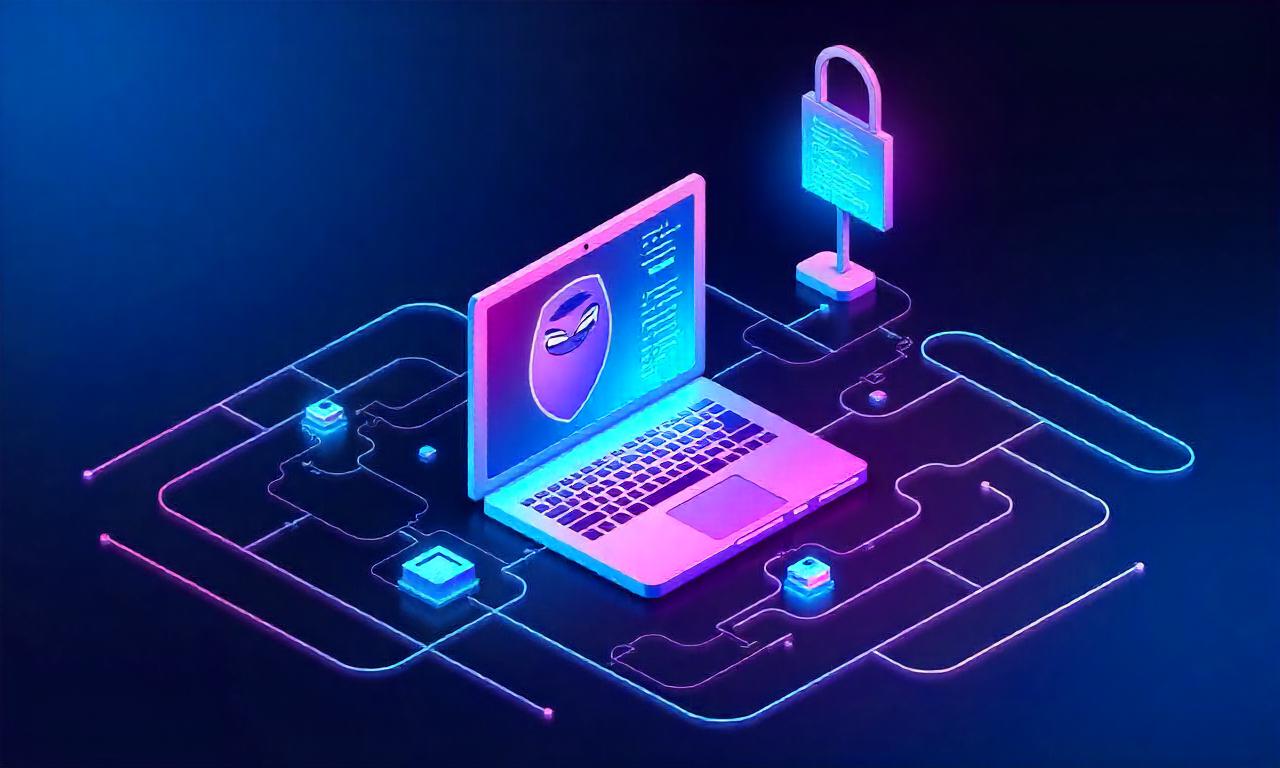What is Split Tunneling in VPN Technology? Explained Simply
In the realm of cybersecurity and network privacy, what is split tunneling in vpn technology has become a critical concept for users seeking to optimize their online experience. Split tunneling is a feature in Virtual Private Network (VPN) software that allows users to route some internet traffic through the encrypted tunnel provided by the VPN while directing other traffic directly through their local internet connection. This dual-path approach offers a unique balance between security, performance, and convenience, making it a popular choice among both casual users and enterprise professionals. As the demand for secure and fast internet access grows, understanding how split tunneling works and its implications can help users make informed decisions about their network configurations. This article will delve into the fundamentals of split tunneling, its mechanics, advantages, disadvantages, use cases, and address common questions to provide a comprehensive overview of this essential VPN feature.
—
Table of Contents
ToggleH2: Understanding the Basics of Split Tunneling
H3: 1. Definition and Core Concept
Split tunneling in VPN technology refers to the ability to separate internet traffic into two distinct paths: one through the VPN tunnel and another through the local network. This means that not all data sent from a device is encrypted and routed through the secure VPN connection. Instead, users can choose which applications or services to route through the VPN and which to use the default internet connection. For example, if you’re using a VPN to access a secure corporate network, you might still use your local connection for streaming services or public Wi-Fi browsing. This flexibility is a key differentiator for users who want to maintain performance while ensuring security for specific tasks.
H3: 2. How Split Tunneling Differs from Regular Tunneling
Unlike regular tunneling, which routes all traffic through the encrypted connection, split tunneling allows for partial routing. Regular tunneling is ideal for users who need complete security, such as accessing sensitive data over public networks. In contrast, split tunneling is beneficial for scenarios where performance is a priority. By keeping some traffic on the local network, users can avoid potential bottlenecks caused by the VPN’s encryption process, which can slow down internet speed. This distinction is crucial for understanding when to use each method and how they impact user experience.
H3: 3. The Importance of Split Tunneling in Modern Networks
With the rise of remote work and the increasing number of devices connected to the internet, split tunneling has emerged as a vital tool for managing network traffic efficiently. It allows users to balance security and speed, which is particularly useful in enterprise environments where employees may need to access both internal resources and external services. Additionally, in personal use, split tunneling can be a game-changer for streaming, gaming, or torrenting while still securing sensitive data. This feature is especially relevant in today’s digital landscape, where users demand both privacy and performance without compromising one for the other.
—
H2: How Split Tunneling Works in Practice
H3: 1. The Mechanics of Split Tunneling
Split tunneling operates by configuring the routing table on a user’s device to direct traffic through different paths based on specific rules or criteria. These rules can be set manually by the user, such as specifying certain IP addresses or domains to route through the VPN, or they can be automatically managed by the VPN software based on predefined settings. When a device connects to a VPN, it establishes a secure tunnel with the remote server, and the traffic that meets the split tunneling criteria is sent through this tunnel. All other traffic bypasses the tunnel and uses the local network, ensuring faster speeds for non-sensitive activities.
H3: 2. Routing Rules and Configuration Options
Most split tunneling configurations are based on IP addresses, domain names, or application-specific settings. For instance, a user might configure their device to route traffic to a company’s internal servers through the VPN while allowing internet traffic to streaming platforms to use the local connection. This level of customization is often available in enterprise-grade VPNs but may be simpler in consumer-focused solutions. Users can also choose split tunneling by location, split tunneling by protocol, or split tunneling by port, depending on the software’s capabilities.
H3: 3. The Role of the Operating System and Router
Split tunneling can be implemented either through the device’s operating system or via the router’s settings. When enabled on the device, the VPN client manages the routing rules, making it user-friendly for individuals. However, router-based split tunneling is often preferred in business environments because it allows centralized control over network traffic for all devices connected to the network. This approach ensures consistency and reduces the risk of misconfiguration by individual users.
—
H2: Advantages of Split Tunneling in VPNs
H3: 1. Enhanced Network Performance
One of the primary benefits of split tunneling is improved speed and reduced latency. By routing non-sensitive traffic directly through the local internet connection, users can avoid the overhead of encryption and tunneling processes, which can be resource-intensive. This is especially valuable for activities like video streaming, online gaming, or large file downloads, where latency can significantly impact the user experience. Split tunneling ensures that these performance-critical tasks are not hindered by the VPN’s encryption.
H3: 2. Flexibility in Traffic Management
Split tunneling provides greater control over which data is encrypted and which is not. This flexibility is ideal for users who need to access both secure internal resources and public internet services. For example, a remote employee might route traffic to the company’s network through the VPN while allowing traffic to social media platforms to use the local connection. This customization allows users to tailor their network setup to their specific needs, balancing security and convenience.
H3: 3. Cost and Resource Efficiency
In enterprise environments, split tunneling can reduce bandwidth usage and lower costs. By keeping non-critical traffic on the local network, companies can save on data transfer expenses while still ensuring secure access to their internal systems. This efficiency also benefits users with limited data plans, as they can conserve data for priority activities while using the local connection for less important tasks. Split tunneling thus offers a cost-effective solution for managing network resources.
—
H2: Disadvantages of Split Tunneling in VPNs
H3: 1. Potential Security Risks
While split tunneling offers convenience, it can also introduce security vulnerabilities. By allowing some traffic to bypass the encrypted tunnel, users may expose sensitive data to unsecured local networks, such as public Wi-Fi or home broadband. This is particularly risky if the local network is compromised, as attackers could intercept data that isn’t protected by the VPN’s encryption. Therefore, split tunneling requires careful configuration to minimize these risks.
H3: 2. Complexity in Setup and Management
Split tunneling requires more technical knowledge compared to regular tunneling. Users must configure routing rules, specify which applications or services to route through the VPN, and ensure consistency across devices. In enterprise settings, this complexity is often managed through centralized policies, but individual users may find it challenging to set up correctly without guidance. This learning curve can be a barrier to adoption for less tech-savvy users.
H3: 3. Inconsistent Security Policies
Split tunneling can lead to inconsistent security practices if not managed properly. For example, an employee might unknowingly route sensitive data through the local network, leaving it vulnerable to monitoring or interception. This inconsistency can be problematic in organizations with strict security protocols, as it may compromise data integrity. Therefore, split tunneling is best suited for environments where users are aware of the configuration settings and understand the trade-offs.
—
H2: Use Cases and Real-World Applications
H3: 1. Enterprise Use Cases
In business environments, split tunneling is commonly used to optimize remote access. Employees can secure access to company servers and internal resources while using the local connection for non-sensitive tasks like email or web browsing. This approach ensures that critical data remains protected while maintaining efficiency for other activities. Additionally, split tunneling reduces the load on the VPN server, improving overall network performance and lowering operational costs.
H3: 2. Personal Use Scenarios
For individual users, split tunneling can enhance their online experience by balancing speed and security. For instance, a user streaming a movie while accessing a secure online banking service via the VPN can enjoy high-quality streaming without noticing a drop in speed. This is particularly useful when using mobile data, as split tunneling allows priority traffic to be handled more efficiently, preserving battery life and data usage.
H3: 3. Hybrid Network Solutions
Split tunneling is often implemented in hybrid networks that combine local and remote connections. This is especially relevant in smart homes or multi-device households, where different devices may require different levels of security. For example, smart home devices can be configured to use the local network for basic functions, while mobile devices use the VPN for secure access to work-related applications. This hybrid approach ensures that security is maintained where needed, without overburdening the network.
—
H2: Best Practices for Implementing Split Tunneling
H3: 1. Configuring Split Tunneling Securely
When setting up split tunneling, it is essential to define clear rules for traffic routing. Users should avoid routing sensitive traffic through the local network unless it is explicitly secured. This can be achieved by blocking access to external networks for critical applications and allowing only necessary traffic through the local connection. Additionally, regularly updating the routing rules ensures that security policies remain effective against new threats.
H3: 2. Choosing the Right Split Tunneling Method
There are two primary methods for implementing split tunneling: device-based and router-based. Device-based split tunneling is easier to configure for individual users, while router-based is more scalable for enterprise networks. The choice depends on user needs, network infrastructure, and security requirements. For personal use, device-based methods are often sufficient, but for organizations, router-based solutions provide centralized management and consistency.
H3: 3. Monitoring and Maintaining Split Tunneling
To ensure the effectiveness of split tunneling, regular monitoring of traffic patterns is recommended. This helps identify any unintended routing of sensitive data through the local network. Additionally, maintaining up-to-date VPN software and operating systems ensures that security vulnerabilities are addressed promptly. Split tunneling should be reviewed periodically to adapt to changing network conditions and user preferences.
—
H2: Split Tunneling vs. Regular Tunneling
H3: 1. Performance Comparison
Split tunneling and regular tunneling differ significantly in performance. Regular tunneling encrypts all internet traffic, which can slow down connections but ensures complete security. On the other hand, split tunneling allows some traffic to bypass encryption, improving speed for non-sensitive tasks. For users prioritizing performance, split tunneling is superior, but for those requiring maximum security, regular tunneling remains the standard.
H3: 2. Security Implications
In terms of security, regular tunneling offers end-to-end encryption, protecting all data from interception. Split tunneling, however, leaves some data exposed to local network risks, such as man-in-the-middle attacks or unsecured Wi-Fi. This makes split tunneling less secure than regular tunneling unless configured properly. Enterprise users should weigh security against convenience when deciding between the two.
H3: 3. Use Case Suitability
Split tunneling is ideal for environments where users need to balance security and performance, such as remote work setups or personal use scenarios. Regular tunneling is better suited for high-security applications, like banking, data transfer, or accessing confidential systems. The choice between the two depends on the specific needs of the user, network requirements, and security policies in place.
—
H2: Split Tunneling and Network Privacy
H3: 1. Privacy Considerations
Split tunneling can affect network privacy depending on how it is configured. If sensitive traffic is allowed through the local network, it could be monitored by local ISPs or network administrators. This privacy risk is common in public Wi-Fi environments, where split tunneling might be used to prioritize speed for non-sensitive activities. Users should evaluate their privacy needs before enabling split tunneling.
H3: 2. Managing Data Leaks
One of the key challenges with split tunneling is preventing data leaks. By allowing some traffic to bypass the encrypted tunnel, users may expose personal data to unsecured networks. To mitigate this risk, users can configure split tunneling rules to block traffic to specific domains or IP addresses that are not essential for security. Additionally, using split tunneling in combination with other privacy tools like firewalls or data encryption can enhance overall security.
H3: 3. Split Tunneling and ISP Monitoring
Split tunneling can impact how ISPs monitor user activity. Traffic routed through the local connection is visible to the ISP, which could track user behavior. In contrast, traffic through the VPN tunnel is encrypted, making it more private. This difference in monitoring is important for users concerned about data privacy. Split tunneling should be used cautiously in environments where ISP monitoring is a concern.
—
H2: Common Questions About Split Tunneling
H3: 1. What are the main benefits of split tunneling?
Split tunneling allows users to balance security and performance by routing some traffic through the VPN and other traffic locally. This can improve speed for non-sensitive tasks while ensuring security for critical applications.
H3: 2. Is split tunneling more secure than regular tunneling?
Split tunneling is less secure than regular tunneling because it allows some traffic to bypass encryption. However, it can still be secure if configured properly and only non-sensitive traffic is routed locally.
H3: 3. Can split tunneling be used on mobile devices?
Yes, split tunneling is available on mobile devices through mobile VPN apps. This allows users to secure certain applications like email or banking while using the local connection for social media or streaming.
H3: 4. How do I enable split tunneling on my device?
Enabling split tunneling depends on the VPN provider and device type. Most consumer-grade VPNs offer split tunneling settings in their app or configuration panel, where users can select specific apps or traffic to route through the encrypted tunnel.
H3: 5. Are there any performance drawbacks to split tunneling?
Split tunneling can reduce performance for tasks that require high-speed internet, especially if too much traffic is routed through the local connection. However, when configured optimally, the impact is minimal and benefits outweigh the drawbacks.
—
H2: Split Tunneling and Its Impact on Business Networks
H3: 1. Optimizing Remote Work Efficiency
Split tunneling plays a crucial role in remote work environments, where employees need to access internal resources securely while still enjoying fast internet for personal tasks. This dual-path approach ensures that business-critical data remains protected while personal activities do not slow down productivity. It also reduces the load on the corporate network, improving overall efficiency and user satisfaction.
H3: 2. Balancing Security and Resource Allocation
In business networks, split tunneling allows companies to allocate resources more effectively. By keeping non-critical traffic on the local network, bandwidth is conserved for high-priority tasks. This resource optimization is particularly beneficial in large organizations with multiple users and devices. Additionally, split tunneling can reduce latency for real-time applications, ensuring smooth operations.
H3: 3. Compliance and Network Management
Split tunneling can aid in compliance with security policies by allowing specific traffic to be encrypted while others are not. This flexibility helps organizations meet regulatory requirements without compromising network performance. Split tunneling also simplifies network management, as policies can be set centrally for all devices connected to the network. However, compliance teams must monitor traffic to ensure that sensitive data is not inadvertently exposed.
—
H2: Future Trends and Developments in Split Tunneling
H3: 1. Integration with AI and Automation
As technology advances, split tunneling is likely to become more intelligent through AI-driven traffic analysis. Future VPNs may automatically determine which traffic to route through the tunnel based on real-time data usage and user behavior, eliminating the need for manual configuration. This automation will enhance convenience and reduce security risks by ensuring optimal routing.
H3: 2. Enhanced User Control and Customization
Next-generation split tunneling solutions are expected to offer greater user control over traffic routing rules. This includes granular settings to specify which apps, ports, or protocols are encrypted and which are not, allowing users to customize their network experience precisely. This level of customization will meet the diverse needs of both personal and enterprise users.
H3: 3. Growing Popularity in IoT and Smart Devices
With the explosion of IoT devices, split tunneling will become more important in managing network traffic for smart homes and industrial systems. These devices often require different levels of security, and split tunneling can ensure that sensitive data is protected while non-critical traffic is handled efficiently. This adaptability will support the scalability of smart networks.
—
H2: How to Choose the Right Split Tunneling Strategy
H3: 1. Assessing Your Network Needs
Before choosing a split tunneling strategy, evaluate your specific requirements. Ask yourself: What is the primary purpose of using a VPN? If speed is a priority, split tunneling may be the best choice. If complete security is essential, regular tunneling might be more appropriate. This assessment will guide your decision on whether to implement split tunneling.
H3: 2. Considering User Expertise
The complexity of split tunneling depends on the user’s technical knowledge. Beginner users may prefer device-based split tunneling with simple settings, while advanced users can customize rules based on traffic types. This flexibility ensures that split tunneling is accessible to all users.
H3: 3. Testing and Monitoring
After implementing split tunneling, regular testing is essential to ensure that traffic is routed correctly. Monitoring network performance and security will help identify any issues or inconsistencies in traffic management. This proactive approach ensures optimal performance and security for both personal and business use.
—
H2: Split Tunneling and Its Role in Cybersecurity
H3: 1. Supporting Multi-Factor Security Strategies
Split tunneling is not a standalone solution but can be integrated with other cybersecurity measures. Firewalls, endpoint security software, and encryption protocols can work in conjunction with split tunneling to enhance overall security. This layered approach ensures comprehensive protection against cyber threats.
H3: 2. Reducing Attack Surface
By allowing only specific traffic to be encrypted, split tunneling can reduce the attack surface for cybercriminals. This selective encryption minimizes the risk of data breaches in scenarios where not all traffic needs protection. However, users must ensure that sensitive data is always encrypted to maintain security.
H3: 3. Adapting to Emerging Threats
As cyber threats evolve, split tunneling is being refined to address new challenges. For example, split tunneling can be configured to block traffic to malicious domains or specific IP ranges, adding an extra layer of security. This adaptability ensures that split tunneling remains a relevant tool in modern cybersecurity practices.
—
H2: The Evolution of Split Tunneling Technology
H3: 1. From Basic Features to Advanced Capabilities
Split tunneling has evolved from a simple feature to a complex networking strategy. Early VPNs primarily focused on complete encryption, while modern solutions now offer split tunneling as an optional feature. This evolution reflects the growing demand for balanced security and performance in today’s digital landscape.
H3: 2. Adoption in Different Sectors
The adoption of split tunneling varies across industries. Technology companies and financial institutions are early adopters, using it to optimize remote access while maintaining security. Healthcare providers and government agencies are also increasingly using split tunneling to secure patient data and government communications without impeding network performance.
H3: 3. Future Potential and Scalability
As networking technology advances, split tunneling is expected to become more scalable and user-friendly. Future developments may include automated routing rules, AI-driven security policies, and integration with cloud-based networks. This scalability ensures that split tunneling will continue to be a key feature in both personal and enterprise networks.
—
H2: Split Tunneling and User Experience

H3: 1. Enhancing Productivity and Convenience
Split tunneling improves user experience by allowing simultaneous access to secure and non-secure services. This convenience is especially valuable for remote workers who need to access both internal and external resources. By avoiding speed bottlenecks, split tunneling supports productivity and user satisfaction.
H3: 2. Balancing Speed and Security for Everyday Use
For everyday users, split tunneling offers a practical solution to balance speed and security. Streaming services and online gaming can operate smoothly on the local connection, while secure applications like banking or email use the VPN for privacy. This balance ensures that users do not have to sacrifice either performance or security.
H3: 3. Reducing Battery Drain on Mobile Devices
On mobile devices, split tunneling can help reduce battery consumption. By limiting the amount of traffic routed through the VPN, device performance and battery life are conserved. This efficiency is crucial for users who rely on mobile data for secure access to online services.
—
H2: Split Tunneling and Network Topology
H3: 1. Understanding Network Topology Requirements
Split tunneling depends on the network topology in which it is implemented. In small businesses or home networks, device-based configurations are common and effective. In larger organizations, router-based split tunneling is preferred for centralized control and consistency. Understanding your network structure ensures optimal use of split tunneling.
H3: 2. How Split Tunneling Fits into Different Architectures
Split tunneling can be implemented in various network architectures, including client-server models, peer-to-peer networks, and hybrid setups. In client-server environments, split tunneling is used to secure access to corporate servers while allowing local traffic to continue uninterrupted. This adaptability makes split tunneling a versatile solution across different network setups.
H3: 3. Ensuring Compatibility with Network Protocols
Split tunneling must be compatible with various network protocols to function effectively. This includes support for TCP, UDP, and HTTP traffic, as well as compatibility with different types of applications like mobile apps, web browsers, and IoT devices. Ensuring protocol compatibility is essential for seamless operation and user satisfaction.
—
H2: Split Tunneling and Its Impact on Data Transfer
H3: 1. Reducing Data Transfer Costs
Split tunneling can lower data transfer costs by directing non-critical traffic through the local network. This efficiency is especially beneficial for organizations with limited data budgets, as it reduces the amount of data that needs to be routed through the secure tunnel. This cost savings can be redirected to other network improvements.
H3: 2. Managing Bandwidth Usage
By separating traffic, split tunneling helps manage bandwidth usage more effectively. This is important for users with limited internet speeds, as high-bandwidth tasks can be handled on the local connection while secure tasks use the encrypted tunnel. This balance ensures optimal use of available bandwidth and improves overall network efficiency.
H3: 3. Supporting Multi-User Networks
In multi-user environments, split tunneling allows for personalized configurations. Each user can set their own routing rules, ensuring that only the necessary traffic is encrypted. This personalization supports diverse user needs while maintaining network security. It also simplifies troubleshooting, as individual users can adjust their settings without affecting others.
—
H2: Split Tunneling in the Context of Cybersecurity Trends
H3: 1. Aligning with Zero Trust Architecture
Split tunneling aligns well with zero trust architecture, which assumes no traffic is trusted by default. By selectively encrypting traffic, split tunneling supports the zero trust model by ensuring that only critical data is protected, while non-sensitive traffic is monitored or left unencrypted based on risk assessment. This strategic approach ensures comprehensive security without overburdening the network.
H3: 2. Integration with Multi-Factor Authentication
Split tunneling can be integrated with multi-factor authentication (MFA) to enhance security. MFA ensures that only authenticated users can access the secure tunnel, while split tunneling manages the rest of the traffic. This combined approach offers multi-layered protection against cyber threats, ensuring that sensitive data remains secure even if non-critical traffic is compromised.
H3: 3. Supporting Cloud-Based Security Solutions
With the growth of cloud computing, split tunneling is being integrated into cloud-based security platforms. This allows users to access cloud resources securely while still using local connections for non-critical tasks. This integration supports seamless user experiences while ensuring data privacy in cloud environments.
—
H2: Split Tunneling and Its Effect on Network Latency
H3: 1. Reducing Latency for Real-Time Applications
Split tunneling can significantly reduce latency for real-time applications like video conferencing, online gaming, and VoIP calls. By routing these applications through the local connection, users can enjoy smoother performance without noticeable delays. This latency reduction is crucial for applications where timing is essential.
H3: 2. Impact on Network Congestion
Split tunneling helps alleviate network congestion by redirecting traffic that is not critical for performance. This optimization ensures that network resources are used efficiently, improving overall reliability. Reduced congestion also enhances the quality of service (QoS) for priority tasks.
H3: 3. Enhancing User Satisfaction in Multi-Tasking Scenarios
In multi-tasking environments, split tunneling supports user satisfaction by ensuring that both secure and non-secure tasks are handled efficiently. This balance ensures that users do not have to choose between speed and security, enhancing their overall experience. Split tunneling thus plays a vital role in optimizing user interactions with networked services.
—
H2: Split Tunneling and Its Role in Cybersecurity Education
H3: 1. Promoting Cybersecurity Awareness
Split tunneling serves as an educational tool for users to understand network security. By managing their own traffic routing, users can learn which data is critical for encryption and which is not. This hands-on experience enhances cybersecurity awareness and encourages best practices for secure internet usage.
H3: 2. Simplifying Security for Non-Technical Users
Split tunneling simplifies security for non-technical users by offering a user-friendly interface. Instead of encrypting all traffic, users can select specific services to secure, reducing complexity. This simplification makes network security more accessible to individuals without advanced knowledge.
H3: 3. Supporting Security Training in Organizations
In enterprises, split tunneling can be used as part of security training programs. By configuring split tunneling rules, employees can learn how to prioritize traffic and secure sensitive data. This practical approach reinforces security protocols and ensures consistent application across the organization.
—
H2: Split Tunneling and Its Impact on Data Privacy
H3: 1. Protecting Sensitive Data While Maintaining Speed
Split tunneling allows users to protect sensitive data while maintaining internet speed for non-critical tasks. This balance is essential for users who need both privacy and performance. By routing specific traffic through the secure tunnel, data privacy is maintained without compromising overall internet experience.
H3: 2. How Split Tunneling Affects Data Encryption
Data encryption in split tunneling depends on traffic routing rules. Critical data is encrypted, while non-critical data is left unencrypted, depending on user settings. This selective encryption ensures that data privacy is maximized for important activities while speed is maintained for others.
H3: 3. Ensuring Data Privacy in Public Networks
In public networks, split tunneling is a key feature for maintaining data privacy. By routing only necessary traffic through the secure tunnel, users can protect their sensitive data from interception on unsecured networks. This strategic approach ensures that privacy is not sacrificed for performance.
—
H2: Split Tunneling and Its Role in Digital Transformation
H3: 1. Supporting Remote Work and Hybrid Models
Split tunneling plays a vital role in digital transformation by supporting remote work and hybrid models. As organizations transition to remote operations, split tunneling ensures secure access to internal systems while allowing seamless access to external services. This adaptability supports digital workflows and maintains user productivity.
H3: 2. Enhancing IoT and Smart Device Security
With the proliferation of IoT devices, split tunneling helps ensure that only critical data is protected. This selective encryption supports smart home devices and industrial systems, reducing the risk of data breaches while maintaining network efficiency. This integration ensures cybersecurity remains a priority even as technology evolves.
H3: 3. Enabling Efficient Resource Allocation in Cloud Environments
In cloud-based networks, split tunneling allows for efficient resource allocation. By directing traffic based on user priorities, organizations can ensure that critical applications receive priority bandwidth, while non-critical traffic is managed through the local network. This efficiency supports digital transformation and ensures that network resources are used optimally.
—
H2: Split Tunneling and Its Impact on Network Management
H3: 1. Reducing Administrative Overhead
Split tunneling reduces administrative overhead by allowing users to manage their own traffic routing. In enterprise environments, this centralized control reduces the need for constant monitoring by network administrators, streamlining operations. This efficiency ensures that network management is both effective and scalable.
H3: 2. Supporting Multi-User and Multi-Device Environments
Split tunneling supports environments with multiple users and devices by allowing for personalized configurations. Each user can set their own split tunneling rules, ensuring that their specific needs are met without affecting others. This flexibility is crucial in large organizations where users have varying requirements.
H3: 3. Ensuring Consistent Network Policies
Split tunneling helps maintain consistent network policies by allowing administrators to define and enforce routing rules. This consistency ensures that security measures are applied uniformly across the network, reducing the risk of configuration errors. Split tunneling thus supports a secure and efficient network environment.
—
H2: Split Tunneling and Its Impact on Network Performance Metrics
H3: 1. Measuring Speed and Latency
Split tunneling can improve speed and latency metrics by directing non-critical traffic through the local network. This optimization ensures that real-time applications perform efficiently without compromising security. Users can monitor these metrics to ensure optimal performance.
H3: 2. Bandwidth Utilization Analysis
Split tunneling supports bandwidth utilization analysis by allowing users to track which traffic is routed through the secure tunnel and which is not. This analysis helps in identifying bottlenecks and optimizing network performance. Bandwidth management becomes more efficient with split tunneling, ensuring that critical tasks receive priority.
H3: 3. Improving User Experience Through Performance Metrics
By improving speed and reducing latency, split tunneling enhances user experience. Performance metrics like download speed, upload speed, and latency can be monitored to ensure that split tunneling is achieving its intended goals. This monitoring helps users fine-tune their configurations for maximum efficiency and security.
—
H2: Split Tunneling and Its Future in Cybersecurity
H3: 1. Emerging Technologies and Integration
Future cybersecurity technologies are likely to integrate split tunneling with other advanced features. This includes AI-driven traffic analysis, automated security policies, and cloud-based encryption solutions. These integrations will enhance the functionality of split tunneling, ensuring it remains relevant in modern network environments.
H3: 2. Scalability in Large Organizations
As organizations grow, split tunneling must be scalable to meet increasing demands. Future solutions may include centralized management tools, real-time traffic monitoring, and adaptive routing algorithms. This scalability ensures that split tunneling can be applied to enterprise-grade networks without compromising performance or security.
H3: 3. Adapting to New Security Threats
Split tunneling will continue to evolve to address new security threats. As cybercriminals develop more sophisticated methods, split tunneling configurations will be refined to block specific traffic or monitor for anomalies. This adaptability ensures that split tunneling remains a powerful tool in cybersecurity strategies.
—
H2: Split Tunneling and Its Role in Network Security Policies
H3: 1. Customizing Security Policies for Different Users
Split tunneling allows organizations to customize security policies based on user roles and device types. For example, executives may have stricter security settings, while casual users may prioritize speed. This customization ensures that security measures are tailored to specific needs, reducing unnecessary restrictions on non-critical traffic.
H3: 2. Supporting Compliance and Regulatory Requirements
Split tunneling can be used to support compliance with regulatory requirements by ensuring that sensitive data is encrypted while non-sensitive traffic is unencrypted. This flexible approach allows organizations to meet compliance standards without impeding user productivity. Split tunneling thus plays a key role in adhering to data protection regulations.
H3: 3. Enforcing Security in Remote Access Scenarios
In remote access scenarios, split tunneling enforces security policies by allowing only authorized traffic to be encrypted. This enforcement ensures that users access internal resources securely while still enjoying the benefits of local connections. This dual-layer security is essential for maintaining data integrity in distributed environments.
—
H2: Split Tunneling and Its Impact on Network Security
H3: 1. Securing Sensitive Data in Hybrid Networks
Split tunneling ensures that sensitive data is securely transmitted through the encrypted tunnel, while non-sensitive data is handled through the local network. This hybrid approach is ideal for environments where data security is critical, such as healthcare or financial sectors. Split tunneling thus supports both security and performance in modern networks.
H3: 2. Mitigating the Risk of Data Breaches
By routing only necessary traffic through the secure tunnel, split tunneling mitigates the risk of data breaches. This selective encryption ensures that critical data is protected, while non-critical traffic is managed through local connections. This strategy reduces the attack surface and supports a layered security approach.
H3: 3. Enhancing Cybersecurity for Everyday Users
For everyday users, split tunneling enhances cybersecurity by allowing them to control which traffic is encrypted. This empowerment ensures that users can maintain privacy for important activities while still enjoying fast internet speeds. Split tunneling thus supports both security and convenience in personal and professional use.
—
H2: Split Tunneling and Its Role in Cybersecurity Education
H3: 1. Teaching Users About Traffic Management
Split tunneling serves as an educational tool for users to understand how traffic is managed in networked environments. By configuring their own split tunneling rules, users learn which data is critical for encryption and which is not, enhancing their cybersecurity awareness. This hands-on experience helps users make informed decisions about their network security.
H3: 2. Simplifying Complex Concepts for Non-Technical Users
Split tunneling simplifies complex cybersecurity concepts for non-technical users. Instead of encrypting all traffic, users can choose to secure only specific applications or services, reducing the learning curve. This simplicity ensures wider adoption and better user compliance with security policies**.
H3: 3. Supporting Cybersecurity Training Programs
Split tunneling is often integrated into cybersecurity training programs to teach users about secure network configurations. This practical approach ensures that users understand the importance of selective encryption and how to apply it in real-world scenarios. Split tunneling thus supports both education and implementation in cybersecurity training.
—
H2: Split Tunneling and Its Role in Data Protection
H3: 1. Ensuring Data Protection for Critical Applications
Split tunneling ensures that critical data is protected through the encrypted tunnel, while non-critical data is handled through the local network. This dual protection allows users to secure important information without compromising performance for less critical tasks. Data protection is maximized in this strategic approach.
H3: 2. Managing Data Exposure in Public Networks
In public networks, split tunneling helps manage data exposure by encrypting only necessary traffic. This strategic exposure ensures that sensitive data is not vulnerable to interception while still allowing for efficient internet access. This balance is essential for users accessing both secure and public resources.
H3: 3. Reducing the Risk of Unintended Data Sharing
Split tunneling reduces the risk of unintended data sharing by allowing users to control which traffic is encrypted. This control ensures that sensitive data is not accidentally shared over unsecured connections, reducing the risk of data breaches. Split tunneling thus supports intentional data sharing and protection in modern networks.
—
H2: Split Tunneling and Its Impact on Network Efficiency
H3: 1. Optimizing Network Efficiency for Business Operations
Split tunneling optimizes network efficiency by **allowing
















